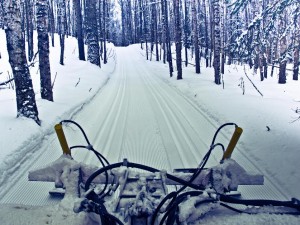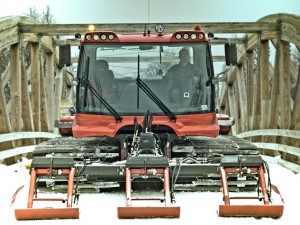Listen to the full audio story:
Today we’re grooming ski trails. The Nordic Skiing Association of Anchorage has a long list of tasks from ski lessons, to biathlon training, to races. But almost all of their focus is devoted to one thing; grooming trails. Anne Gore is the Executive Director of the NSAA, and she says the group is one big snow club.
“It’s pretty clear in our business that everybody loves it when it snows. The more the better, and if it’s the soft fluffy snow we love it,” Gore says.
But the 2013 snow year has been a poor one. You might think that would mean less work for the NSAA, but Gore says it’s the opposite.
“We are capable of converting this hard packed ice into skiable snow, but it does take more hours from our staff, and more fuel that we’re burning up because we’re driving the machines for longer hours and going over the tracks multiples times,” Gore says.

And that extra work can be taxing on a group that is run mostly by volunteers. Gore says the NSAA has about 100 volunteers, but only six full time employees, four of them groomers. Ben Powell is one of them, and right now he’s showing me his groomer parked outside the NSAA headquarters in Kincaid Park.
“This one’s about 36 feet long and about 18 feet wide. They’re actually pretty light, because they’re made to go on snow. So they look big, but they’re not heavy,” Powell says.
Powell has been grooming trails for about 35 years, which makes him quite the fountain of knowledge considering there aren’t schools or classes that teach grooming.
“I wish there was a class, but you just kind of learn as you go. It’s a real small group of people throughout the world, and the industry is really young,” Powell says.
Powell says the rig works on the snow, or in this case the ice in three parts. The front has claws that scrape the ice, the treads in the middle have blades that chop the ice, and then the tiller in the back smoothes the snow-like material that is left behind. Powell says it sounds complex, but it’s not.

“Grind it to smithereens. It’s kind of like if you put something in a mixer or a blender and just kept chopping it until you get the right consistency,” Powell says.
Today we’re going to do some grooming for the Kincaid biathlon stadium, but first – my question: what kind of music do we listen to? I’m thinking he’s got to say something like Led Zeppelin. You’re driving a huge rig, it’s loud, you’re cranking gears. Yeah, that’s grooming music right there.
“I like ‘Fresh Aire’ by Mannheim Steamroller. That’s some of my favorite grooming music,” Powell says.
Not what I was expecting, but it does sort of make sense. Powell usually grooms at night when the trails are empty. He says it’s peaceful, sometimes even meditative. But on an icy day like today we can’t listen to music, because we need to hear what the groomer is doing.
“We see our product out the back, but we can’t see a lot of what our actual tool is doing. So our ears tell us a lot of what we need to know,” Powell says.
Things like whether or not the tiller is grinding too hard into the ice. Powell says you have to listen for that perfect balance.
“Like the Tibetan singing bowls. The noise comes on slowly, and then you just keep on adjusting things by the noise,” Powell says.
Powell says even though it seems repetitive, he never tires of his job. He’s always trying to perfect his craft, and he rarely has a boring night.
“I’ve had just about every crazy thing happen. Most interesting thing that happens with the animals is that if we have a high rabbit population, the owls will sit up in the trees and wait until the groomer goes by. And when the lights hit a rabbit they tend to freeze. So all of a sudden there will be an owl that will fly right over the Sno-Cat and hit a rabbit 100 feet out or so,” Powell says.
As we finish up our fifth lap on the biathlon trial I’m starting to see some progress. What was basically an ice rink is starting to form into a mixture of ice and what looks like fresh snow. It’s happening slowly though.
“This is a really good example of how we recover a trail. If you just gave up easy you’d take one or two passes and say ‘I can’t do it. ‘But what happens is after you’ve done it a while it will really start to come around. So tenacity, and being too dumb to quit is sort of part of the job,” Powell says.
And that kind of tenacity is what has kept the NSAA going strong for more than 50 years. Executive Director Anne Gore says their group has been around almost as long as we’ve been a state.
“I’m not sure what it says about our city but I think some people would definitely say this is a ski town, and it’s always been a ski town. It’s a really important part of our cities history and it’s interesting to look back at how skiing has been part of this place for as long as we’ve existed,” Gore says.
Dave Waldron began his radio career in 2000 as a volunteer DJ at UAA’s radio station KRUA 88.1, where he hosted a weekend music show. In 2004 he was hired as the station’s music director, and held the position until his graduation in 2007. He was hired by Alaska Public Media in 2008 and since then has worked as an audio engineer, editor, and producer. He currently runs his own small business AK Audio Pro, and is a host of Alaska Public Media’s Hometown, Alaska.




